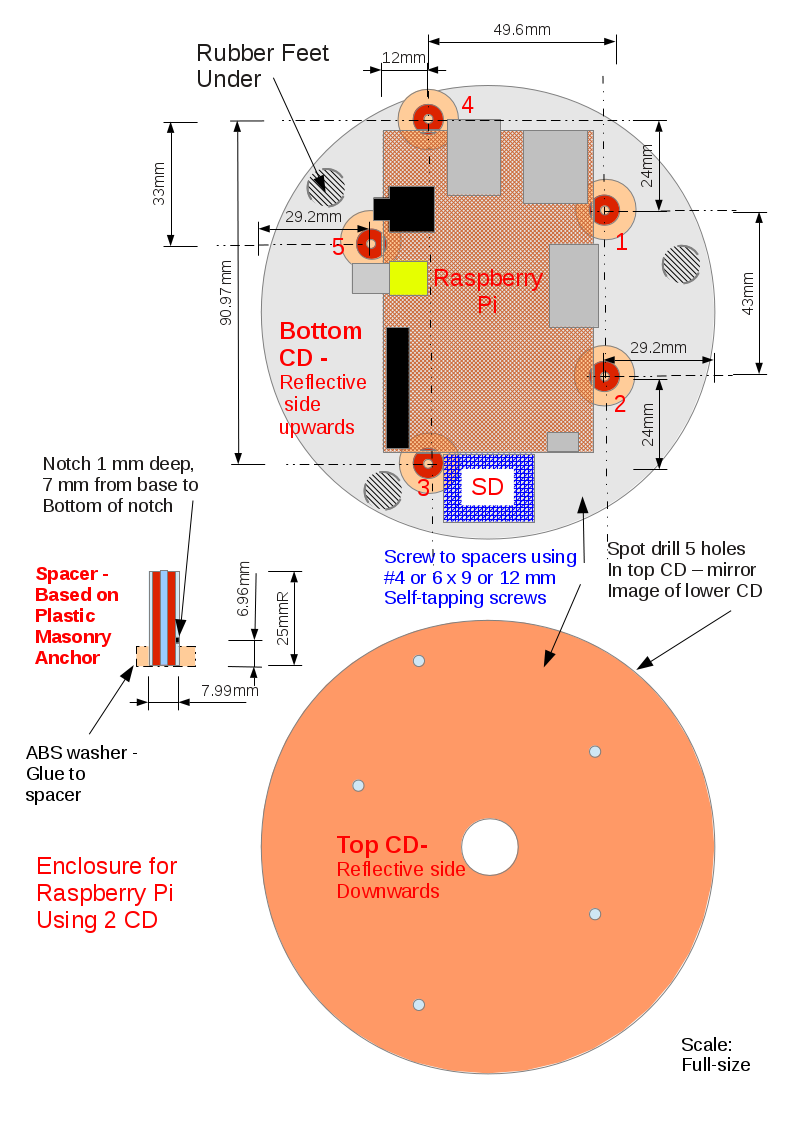Raspberry Pi
A growing body of information is available at http://www.raspberrypi.org
Only a few critical issues, that are easily overlooked, are summarised below
Models
Most will purchase the model B, which has Ethernet and more USB ports
The second release of model B has 512 MB RAM in lieu 256 MB
- likely to increase the variety of OS that are usable
- earlier boards are not upgradeable, because all components are soldered in place
Case
The basic product is sold without a case. It does not fit in any "standard" blank case and has sockets on both sides as well as all four edges, making construction of a suitable case not a simple task.
Cases are now being sold on the Raspberry Pi site. Alternatively, third-party cases are also marketed
The two (only) chips on RPi can get quite hot in operation. Small, self-adhesive heatsinks are now available from:
Heat Load
Quick Start Guide from distributor RS Components recommends:
- "use in well-ventillated area"
- "should not be covered"
It's debatable whether or hot the majority of cases being sold meet the above criteria.
Alternatives to Cases
A DIY cover can be made usiing discarded CD media. The original concept was at
That "case" does not anchor the RPi down and dimensions for accuately positioning the plastic supports are not provided. A variation, including critical dimensions is at
Some construction factors to note, In either variant
- RPi have been produced on at least two production lines
- precise dimensions of the board might vary
- check prior to construction, preferably using plastic vernier calipers
- adjust position of supports accordingly
- single plastic disks/CD media, although quite tough, are fairly flexible
- two can be "laminated" together to form each of the top and base
- the plastic in them is not tolerant of most solvents/glues - alternative is to place near the perimeter:
- several small dots of hot-melt glue or
- several strips of (non-foam) "double-sided" tape
- metal components of the case must be well insulated
- surprising force is required to insert/remove the SD Card & USB plugs, in particular. The supports must resist horizontal movement of the board
- the board is offset longitudinally towards the USB/RJ45 end, in order to:
- facilitate insertion removal of USB/Ethernet plugs
- prevent SD card overhanging case
- a minimium standoff of about 7 mm is required for board above lower CD.to facilitate insertion/removal of plugs
- if actual CD media are used (in lieu of plastic spacers from CD stacks) then the reflective sides must face inwards
- top sides of media can be conductive aluminium
- clear any drillled holes of flaked aluminium swarf
- reflective surfaces aid monitoring of the RPi's five tell-tale LED
- drill CD media at slow speed
- otherwise the plastic is inclined to melt and clog drlll bits
- on early production (at least) of the RPi model B, the Ethernet socket is not well anchored
- desirable to adhere plastic spacers above it so the top CD holds it down
- a discarded case from a stack of 20/25 CD/DVD media can be used to protect the "CD-RPi" during transport
- need to cut off the central spigot of the media case
Circuit Board
Power is supplied via the micro-USB connector at one end. The surface-mounted capacitor behind that connector is a known physical weak-point.
- do not grip the board by that capacitor
- preferably leave the micro-USB power cable permanently plugged in and power ON?OFF by either
- powering the plug-pack/USB-hub ON?OFF or
- disconnecting the other end of the power cable
Power Supply
- A raspberry pi draws 0.7A (700 mA) of regulated 5V power, which is beyond the capacity of most:
- USB sockets on a computer
- mains-USB plug packs
- Suitable power supplies include
- mains-USB plug packs rated at 1A
- preferably having a single USB socket only
- USB-hubs capable to delivering 1 A to a single USB socket
- "Zipp" brand from Big W does - but check before purchasing
- mains-USB plug packs rated at 1A
- although the use of a USB-hub as a power source is deprecated by the manufacturers, it has been used sucessfully by the developers at http://www.ipfire.org. Critical factors are:
- regulated power to the hub
- 1 A available to a single socket
Rpeters12:53, 26 January 2013 (EST)
